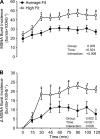Influence of endurance training on central sympathetic outflow to skeletal muscle in response to a mixed meal
- PMID: 20110544
- PMCID: PMC2853201
- DOI: 10.1152/japplphysiol.01174.2009
Influence of endurance training on central sympathetic outflow to skeletal muscle in response to a mixed meal
Abstract
Nutrient intake is accompanied by increases in central sympathetic outflow, a response that has been mainly attributed to insulin. Insulin-mediated sympathoexcitation appears to be blunted in insulin-resistant conditions, suggesting that aside from peripheral insulin insensitivity, such conditions may also impair the central action of insulin in mediating sympathetic activation. What remains unclear is whether an insulin-sensitive state, such as that induced by chronic endurance training, alters the central sympathetic effects of insulin during postprandial conditions. To examine this question plasma insulin and glucose, muscle sympathetic nerve activity (MSNA), heart rate, and arterial blood pressure were measured in 11 high-fit [HF; peak oxygen uptake (V(O(2peak))) 65.9 +/- 1.4 ml x kg(-1) x min(-1)] and 9 average-fit (AF; V(O(2peak)) 43.6 +/- 1.3 ml x kg(-1) x min(-1)) male subjects before and for 120 min after ingestion of a mixed meal drink. As expected, the insulin response to meal ingestion was lower in HF than AF participants (insulin area under the curve(0-120): 2,314 +/- 171 vs. 4,028 +/- 460 microIU x ml(-1) x 120(-1), HF vs. AF, P < 0.05), with similar plasma glucose responses between groups. Importantly, following consumption of the meal, the HF subjects demonstrated a greater rise in MSNA compared with the AF subjects (e.g., 120 min: Delta21 +/- 1 vs. 8 +/- 3 bursts/100 heart beats, HF vs. AF, P < 0.05). Furthermore, when expressed relative to plasma insulin, HF subjects exhibited a greater change in MSNA for any given change in insulin. Arterial blood pressure responses following meal intake were similar between groups. Collectively, these data suggest that, in addition to improved peripheral insulin sensitivity, endurance training may enhance the central sympathetic effect of insulin to increase MSNA following consumption of a mixed meal.
Figures




Similar articles
-
Regional sympathetic nervous activation after a large meal in humans.Clin Sci (Lond). 1995 Aug;89(2):145-54. doi: 10.1042/cs0890145. Clin Sci (Lond). 1995. PMID: 7554755
-
Water drinking enhances the gain of arterial baroreflex control of muscle sympathetic nerve activity in healthy young humans.Exp Physiol. 2018 Oct;103(10):1318-1325. doi: 10.1113/EP087095. Epub 2018 Aug 28. Exp Physiol. 2018. PMID: 30055008
-
GABAA receptors modulate sympathetic vasomotor outflow and the pressor response to skeletal muscle metaboreflex activation in humans.J Physiol. 2019 Aug;597(16):4139-4150. doi: 10.1113/JP277929. Epub 2019 Jul 17. J Physiol. 2019. PMID: 31247674
-
The impact of exercise training on muscle sympathetic nerve activity: a systematic review and meta-analysis.J Appl Physiol (1985). 2024 Aug 1;137(2):429-444. doi: 10.1152/japplphysiol.00060.2024. Epub 2024 May 16. J Appl Physiol (1985). 2024. PMID: 38752285
-
Sympathetic neural adaptations to exercise training in humans: insights from microneurography.Med Sci Sports Exerc. 1998 Mar;30(3):387-91. doi: 10.1097/00005768-199803000-00008. Med Sci Sports Exerc. 1998. PMID: 9526884 Review.
Cited by
-
Influence of spontaneously occurring bursts of muscle sympathetic nerve activity on conduit artery diameter.Am J Physiol Heart Circ Physiol. 2013 Sep 15;305(6):H867-74. doi: 10.1152/ajpheart.00372.2013. Epub 2013 Jul 5. Am J Physiol Heart Circ Physiol. 2013. PMID: 23832696 Free PMC article.
-
Effects of short-lasting supramaximal-intensity exercise on diet-induced increase in oxygen uptake.Physiol Rep. 2017 Nov;5(22):e13506. doi: 10.14814/phy2.13506. Physiol Rep. 2017. PMID: 29151442 Free PMC article.
-
Role of habitual physical activity in modulating vascular actions of insulin.Exp Physiol. 2015 Jul 1;100(7):759-71. doi: 10.1113/EP085107. Exp Physiol. 2015. PMID: 26130183 Free PMC article. Review.
-
Influence of physical inactivity on arterial compliance during a glucose challenge.Exp Physiol. 2018 Apr 1;103(4):483-494. doi: 10.1113/EP086713. Epub 2018 Feb 14. Exp Physiol. 2018. PMID: 29315921 Free PMC article.
-
Spontaneous bursts of muscle sympathetic nerve activity decrease leg vascular conductance in resting humans.Am J Physiol Heart Circ Physiol. 2013 Mar 1;304(5):H759-66. doi: 10.1152/ajpheart.00842.2012. Epub 2013 Jan 4. Am J Physiol Heart Circ Physiol. 2013. PMID: 23292718 Free PMC article.
References
-
- ACSM ACSM's Guidelines for Exercise Testing and Prescription (6th ed.) Philadelphia, PA: Lippincott Williams and Williams, 2000
-
- Acheson KJ. Influence of autonomic nervous system on nutrient-induced thermogenesis in humans. Nutrition 9: 373–380, 1993 - PubMed
-
- Berger M, Kemmer FW, Becker K, Herberg L, Schwenen M, Gjinavci A, Berchtold P. Effect of physical training on glucose tolerance and on glucose metabolism of skeletal muscle in anaesthetized normal rats. Diabetologia 16: 179–184, 1979. - PubMed
-
- Berne C, Fagius J. Metabolic regulation of sympathetic nervous system activity: lessons from intraneural nerve recordings. Int J Obes Relat Metab Disord 17, Suppl 3: S2–S6; discussion S22, 1993 - PubMed
Publication types
MeSH terms
Substances
Grants and funding
LinkOut - more resources
Full Text Sources
Medical
Research Materials
Miscellaneous

